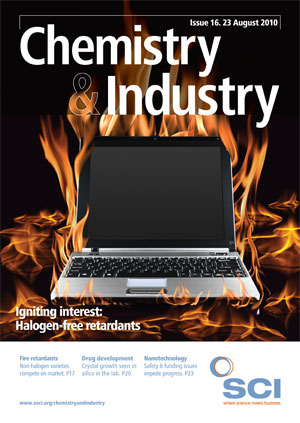Environmental concerns have prompted the development of new non-halogenated flame retardants, but not all brominated retardants are bad, reports Maria Burke
Brominated flame retardants (BFRs) became a topic of environmental concern in the late 1980s when it was discovered that some of them could form halogenated dioxins and furans when burnt. Environmental campaigners argue that several BFRs have known toxic properties, persist in the environment and build up in the tissues of animals and humans. PBDEs, for example, have been found in human breast milk, blood and fat, house dust and indoor air, fish, birds, beef, dairy products and sediments.
The Restriction on Hazardous Substances
However, ‘the reality is that while a handful of brominated products present issues for human health and/or the environment, and are therefore restricted, the majority of them – and there are over 75 BFRs – do not,’ says Phil Hope of the European Brominated Flame Retardant Industry Panel (EBFRIP).
In the EU, the Waste of Electric and Electronic Equipment (WEEE) directive makes it illegal not to separate out BFR-containing plastics before waste treatment. Since 2006, the Restriction on Hazardous Substances in electrical and electronic equipment (RoHS) directive restricts the use of polybrominated biphenyls (PBB) and PBDEs to below 0.1% or 1000ppm by weight of individual material. In autumn 2010, the European Parliament and the Council of Ministers will consider Commission proposals to revise the RoHS directive. In June 2010, members of EP’s Environment Committee voted to include all organobromines and organochlorines on a priority list of substances, Annex III, for review by the Commission by mid-2014.
Several electronics companies are already working to phase-out BFRs. An alliance, including Acer, Dell and Hewlett-Packard, together with public interest organisations ChemSec, Clean Production Action and the European Environmental Bureau, has called for a ban on all BFRs in electronics sold from 2016. ‘[The EP committee decision] is a missed opportunity,’ says Christian Schaible of EEB. ‘There are already products on the market free of halogenated FRs, so MEPs could have simply rubber-stamped the phase-out of these chemicals.’
A recent report by ChemSec,1 for example, found that most BFRs have been removed from over 500 products on the market today, including mobile phones, computers and TVs. The survey, which covered 28 electronic companies, including Apple, Nokia and Philips, found that 23 had at least one product on the market free, or almost free, from BFRs, and three out of four companies stated that by 2014 they will have products totally free from BFRs and/or PVC on the market.
‘Our report testifies to the fact that alternatives are available and cost effective, and suppliers are ready to scale up their production of these alternative materials,’ says ChemSec’s Nardono Nimpuno. Virtually every major supplier of engineering compounds for electronic applications has introduced non-halogenated alternatives, many with improved technical properties, he adds; many have conducted two or three years of field testing.
Alternative halogen-free flame retardants (FRs) cover a diverse range of chemicals that can be classified as inorganic, which includes mainly metal hydroxides like aluminium hydroxide and magnesium hydroxide; phosphorus-based, which includes organic and inorganic phosphates, phosphonates and phosphinates, as well as red phosphorus; and nitrogen-based, which includes melamine and melamine derivatives often used in combination with phosphorus-based flame retardants. Many different technologies are necessary because FRs must match many different polymer properties and processing requirements.
Non-halogenated alternatives are commercially available and used, says Manfred Doering of the Karlsruhe Institute for Technology in Germany. ‘For many polymers, like epoxy resins (printed wiring boards), engineering plastics and commodities, too, commercially available non-halogenated FRs are on the market, and accepted under the EU’s REACH legislation. If REACH-accepted non-halogenated FRs are available, everybody can switch.’ Nevertheless, Doering points to a 2007 report,2 which he coauthored, that found that most halogen-free FRs pose no harm to the environment and do not bioaccumulate.
While there are examples of halogen-free products on the market, EBFRIP’s Hope stresses that there are also many other cases where alternatives have not been identified. Direct substitution of one FR by another is rarely straightforward, he cautions. Hope continues: ‘Beyond technical feasibility, the real question is whether the substitution of these compounds by other chemicals constitutes an environmental or health benefit? It seems that the driver for some electronics companies to offer “green halogen-free” products is their marketing strategies.’
A 2009 market study3 by the trade group, the Phosphorus, Inorganic and Nitrogen Flame Retardants Association (PINFA), found that in recent years halogen-free FRs have increasingly replaced conventional halogenated FRs in plastics used in the European electrical and electronics sector. It attributed this to growing public environmental awareness, legal regulations and ‘an equal ranking of both types of flame retardants in terms of cost and technology’. Costs of brominated flame retardants have increased drastically, it adds.
Meanwhile, in the US, the $827m flame retardant industry is expected to grow at a rate of 3%/year through 2011, according to market researcher Freedonia in a 2009 survey.4 Phosphorus-based types will grow the fastest, while brominated compounds will continue to lead the market in total value. Rapid gains are expected for smaller-volume FRs such as magnesium hydroxide, which is finding increased use in polypropylene and engineering resins. Alumina trihydroxide will remain the largest-volume FR through 2011, comprising 45% of demand and growing in line with the whole market, the study says.
Many companies have chosen to enter the market for alternatives, including DuPont, Albemarle, Sabic, BASF and DSM, as well as smaller outfits such as Ticona Engineering Polymers, Huber Engineering Materials, Italmatch Chemicals and Chemtura.
The German speciality chemicals group Lanxess, for example, brings to the table a range of halogen-free FRs, such as Levagard DMPP. It has an extremely high phosphorus content and low viscosity, making it useful in rigid foam materials, coatings, adhesives, epoxy resins and other thermosetting plastics. It can also be used with inorganic FRs since its low viscosity allows larger quantities of these halogen-free additives to be added to the matrix polymer.
‘Levagard DMPP has recently become increasingly important as an excellent alternative to dimethyl methylphosphonate, DMMP,’ explains Heiko Tebbe, head of business development phosphorus chemicals in Lanxess’ Functional Chemicals business unit. ‘According to current EU regulations, this chemical must be labeled as “toxic”. We have a good solution for customers who, due to legislative pressure, need an alternative to this liquid flame retardant.’
Halogen-free products

There are plenty of research papers illustrating the progress made in advancing non-halogenated FRs. For example, scientists at the Middle East Technical University in Ankara, Turkey, have shown that halogen-free phosphorus-based flame retardants are very effective in short glass fibrereinforced polyamides. The flame retardants were a combination of a red phosphorus master batch and an organic phosphorus-aluminium-melaminezinc borate compound. They showed better fire safety properties than halogenated FRs.5
Another interesting study, by researchers from South China University of Technology, reported that polypropylene polymer could be effectively treated for fire safety using aluminium and magnesium hydroxide FRs. Polypropylene offers good insulating and processing properties, with good mechanical and chemical resistance, but cannot be used in many applications because of its flammability. The team found that ‘horizontal burning velocity’ was decreased by up to 50% and smoke density was significantly reduced when zinc borate was added as a synergist.6
Many chemicals manufacturers are developing new products and the electronics sector is working towards a complete phase-out of BFRs, but there are other companies that have yet to follow and are awaiting clear signals from lawmakers, says ChemSec’s Nardano Nimpuno. ‘It is unsatisfactory that legislators do not provide them with sustainable guidance on which direction to move. The technical capability is there, the science is there, but the legislators are flinching.’ On the other side of the fence, EBFRIP is urging legislators not to be pushed by NGOs to introduce substance bans immediately into the RoHS directive without establishing sufficient risk. By autumn 2010, Europe’s regulators should have decided how to proceed. But whatever they decide, the market for non-halogenated FRs looks set to grow.
The halogen-free alternatives
Phosphorus: Phosphorus-containing FRs are widely used in standard and engineering plastics, polyurethane foams, thermosets, coatings and textiles. The most important are phosphate esters, phosphonates and phosphinates. They work by forming a protective ‘char’ layer that resists high temperatures and protects the underlying product from attack by oxygen and heat. This minimises the development of a full fire and increases escape time.
Inorganic: The most common inorganic flame retardants are aluminium trihydroxide (ATH) and magnesium hydroxide (MDH). ATH is by far the most widely used flame retardant by tonnage. It inhibits fire by releasing water that cools and dilutes the flame zone, but it decomposes around 200°C. MDH is stable up to temperatures of around 300°C so it is used in polymers that have higher processing temperatures.
ATH and MDH, grain sizes 2 μm, are used in thermoplastics like cable PVC or polyolefins for cables. They can be coated with organic materials to improve their compatibility with the polymer. Coarser grades can be used for electrical applications, seats, panels and vehicle parts.
A number of other inorganic substances are used as ‘synergists’ to enhance performance of other FRs or to bring a specific benefit like smoke suppression. For example, borates are used to protect cotton. They do this by releasing water and forming a glassy coating that protects the surface.
‘Intumescent’ flame retardant systems expand to produce protective foams and are used as coatings to protect combustible materials, such as wood and plastics, as well as steel structures.
Nitrogen-based: There are three main groups: pure melamine, melamine derivatives – salts with organic or inorganic acids such as boric acid, cyanuric acid, phosphoric acid – and melamine homologues – melam, melem and, experimentally only, melon. In the condensed phase, it is thought that melamine is transformed into crosslinked structures that encourage char formation. In the gas phase, it is thought that the release of molecular nitrogen dilutes volatile polymer decomposition products.
Melamine is mainly used in polyurethane foams, whereas melamine cyanurate is used in nylons or in polypropylene intumescent formulations together with ammonium polyphosphate. The phosphate, poly- and pyrophosphates of melamine contain both nitrogen and phosphorus, and are used in nylons. In some specific formulations, triazines, isocyanurates, urea, guanidine and cyanuric acid derivatives are used as reactive compounds.
Source: PINFA, http://www.pinfa.eu/non-halogenated-frs
Maria Burke is a freelance science writer based in St Albans, UK.
References
1.http://www.chemsec.org/news/539-chemsec-reportlists- 500-products-free-from-brominated-flameretardants- and-pvc
2.http://www.halogen-free.org/HFFR_Brochure.pdf
3.http://www.pinfa.eu/uploads/Documents/pinfa_HFFR_ Brochure_2009_web.pdf
4.http://www.freedoniagroup.com/Flame-Retardants.html
5. N. A. Isitman, H. O. Gunduz and C. Kaynak, Journal of Fire Sciences, 2010, 28; 87.
6. J. Liang and Y. Zhang, Polymer International, 2009, 59(4), 539.





